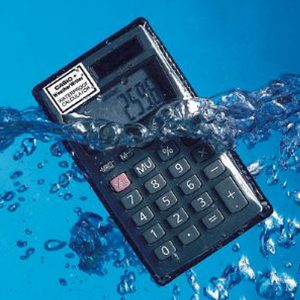Does Parylene Make my Product Waterproof?
Posted by Sean Horn
Friday, August 24, 2018 7:30
@ 7:30 AM
Protecting printed circuit boards (PCBs) and similar electronics from the incursion of water is an essential responsibility of parylene (XY) conformal coating. Suitable XY permeation barriers assure no form of liquid passes through to underlying components and that the water vapor transmission rate (WVTR) is minimal. WVTR measures the level of water vapor migration through the applied barrier film, in terms of area and time. Optimal WTVR ratings are represented by lower numerical values. In comparison to liquid coatings, parylene typically provides lowest-level values, indicating better moisture barrier provision.

Acrylic, epoxy, silicone and urethane coatings can be more quickly affected by water, its vapor, and other sources of moisture, such as:
- acid rain,
- mists of other airborne pollutants,
- salt-air and
- chaotic weather.
Demonstrating greater moisture barrier management, XY is also suitable film protection for bio-implantable medical devices that need to withstand the presence of internal sources of moisture within the body.
Of all XY types, Parylene C has the best water vapor barrier properties. Table 1 lists the WVTR of five XY types, as well as those for several liquid conformal coatings.
Table 1: WVTR Barrier Properties of Parylene and Liquid Conformal Coatings
Polymer WVTR, (g·mm)/(m2·day)
Parylene C 0.08
Parylene N 0.59
Parylene D 0.09
Parylene F (VT-4) 0.28
Parylene AF-4 0.22
Epoxy (ER) 0.94
Polyurethane (UR) 0.93
Silicone (SR) 0.89
These data demonstrate the superiority of all parylene types as a barrier against water vapor incursion, in comparison to major liquid coatings. Types C and D have particularly low WVTR-levels. However, it should be noted that some passage through the XY film will eventually occur, suggesting incomplete water-proofing over time.
Table 2 provides further substantiation of Parylene C’s superior moisture barrier performance compared to ER, UR, SR and TeflonTM materials, following immersion in saline solution of sodium chloride and water.
Table 2. Resistance of Different Polymers to 0.9% Saline Solution
Polymer Coating Method Layer Thickness Time Until Total
(microns, μm) Breakdown
Parylene C CVD 25 > 30 days
ER Dip Coating 100 ± 25 6 hours
UR Dip Coating 100 ± 12.5 6 hours
SR Dip Coating 75 ± 12.5 58 hours
TeflonTM Spraying 75 6 hours
Data in Table 2 once again shows parylene’s water barrier superiority, requiring far longer to be breached by a saline solution (30+ days) than any of the liquid coatings and TeflonTM, at lesser coating thicknesses, 25 μm. Of the other coatings, only SR exceeds 6 hours, offering 2 days/10 hours protection. If the XY coating were expanded to levels of the other listed coatings (75+ μm), breakdown time would commensurately expand, to 90 days or more. However, cases where protected devices would be expected to function in a salt solution for more than 30 days are rare; specialized XY-coating procedures could assure the parylene conformal film would remain functionally waterproof under most operating conditions.
Products that depend on no-fail functionality — such as for aerospace/defense, industrial, medical, and telecommunications – require stringent water barrier performance for enclosures, gaskets, and hermetic sealing. Parylene exceeds liquid coatings for water barrier protection. XY’s lesser weight and thinner coats also improve fuel efficiencies for automotive/aerospace applications and internal positioning for biomedical uses. In this respect, parylene qualifies for Class B specification, according to IPC-CC-830B, as a hydrolytically-stable conformal coating, requiring higher levels of moisture insulation resistance and humidity-aging testing. Regarding any moisture penetration and interference, this covers operating situations where acid rain, aggressive solvents, atmosphere pollutants, high humidity, intermittent immersion, persistent rain, snow and salt fog, as well as internal environments with high moisture/liquid content are commonly encountered.
Table 3 shows water absorption rates and temperatures for Types F, C and D.
Table 3
Parylene Type F C N
Water absorption 0.01%/24 hours 0.06%/24 hours 0.02%/24 hours
Water vapor temperature
@ 38°C, g.mm/(m2.j) 0.32 0.10 0.25
Once again, Parylene C demonstrates the highest level of water repulsion, closest to complete device waterproofing.
To review, moisture barrier properties of the parylenes which support conditional water-proofed performance include:
- Very low WVTR for a conformal polymer film.
- Minimal liquid water uptake/absorption.
- Exceptionally limited ionic permeability; salts pass through the coating slowly and with great difficulty.
- Low coating porosity; parylene CVD forms a pinhole/pore-free coating at a thickness of 5 – 8 microns.
Will parylene make your product completely waterproof?? Probably not, at least under the most extreme conditions. If an XY-coated device was submerged at the bottom of the ocean (or your kitchen sink) for an extended period – months or more – it may not remain dry, rendering its continued functionality questionable. It might continue to work, but there’s a distinct probability it wouldn’t. However, this is an unlikely scenario. Parylene’s CVD-generated protection – which provides internal as well as external security – repels water and other sources of moisture with exceptional barrier control, under an extensive range of operational conditions, making it virtually waterproof for the vast majority of foreseeable performance circumstances. Specialized XY-coating measures can be engineered for operating conditions where greater-than-average exposure to moisture are expected.
To learn more about properties of parylene, download our whitepaper now:
Download our guide on Parylene 101
Comments
Homepage 4/17/2020. 10:17:10 AM
... [Trackback] [...] Informations on that Topic: blog.paryleneconformalcoating.com/whats-the-difference-between-potting-and-conformal-coating/ [...]

londondrugscanada.bigcartel.comlondon-drugs 4/17/2020. 10:17:10 AM
cialis uk https://londondrugscanada.bigcartel.com/london-drugs This is nicely expressed. !